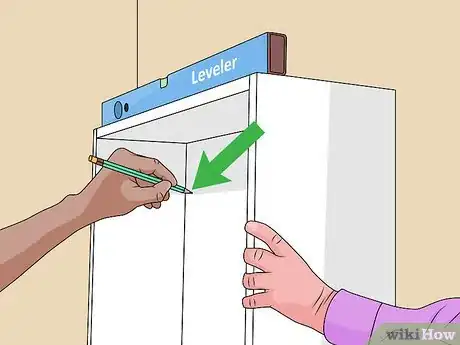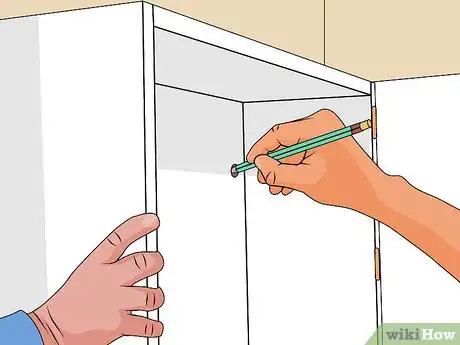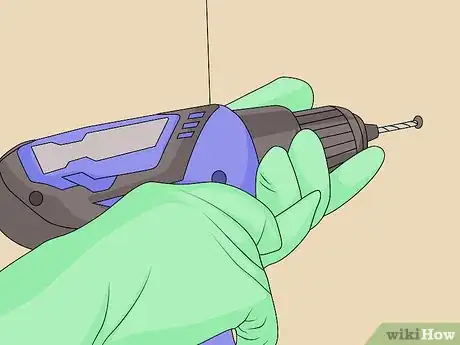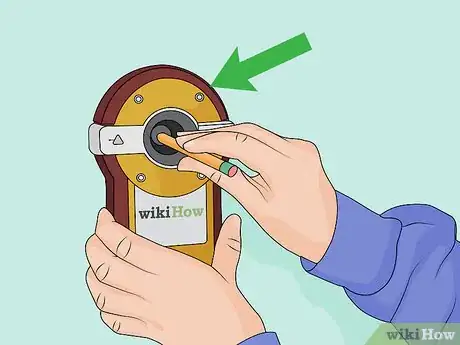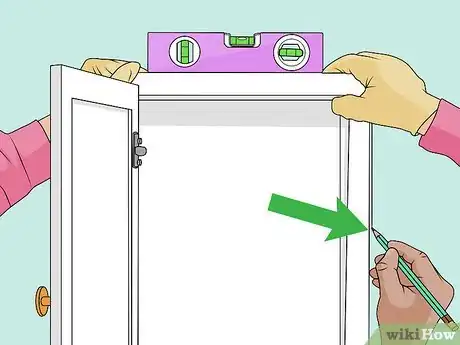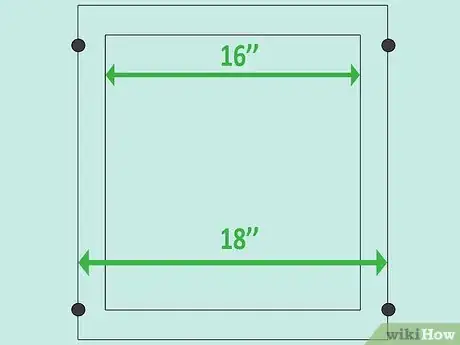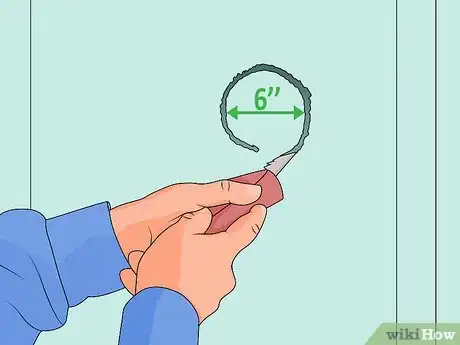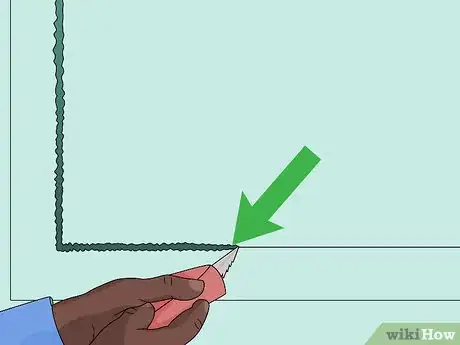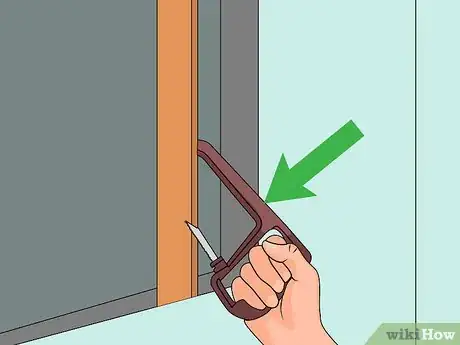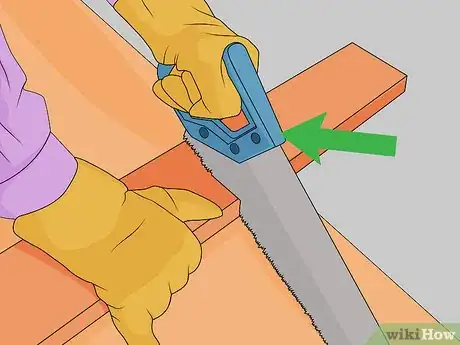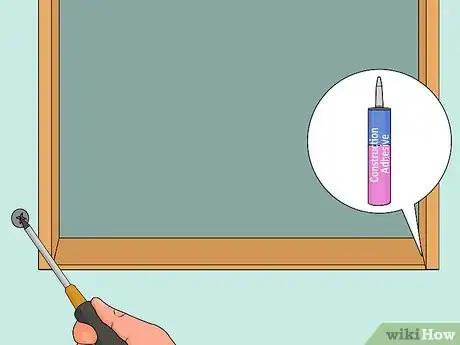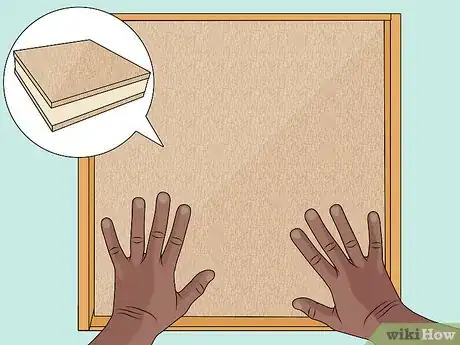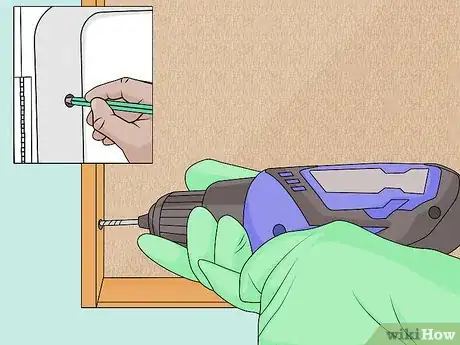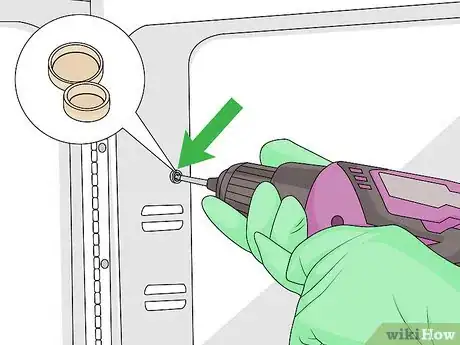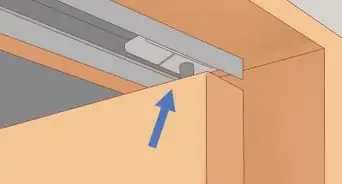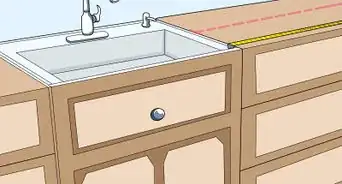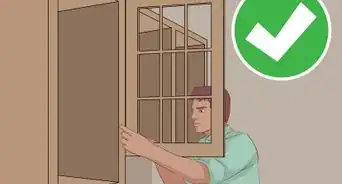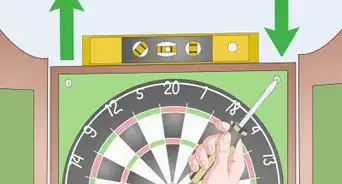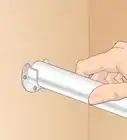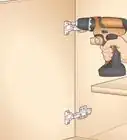This article was co-authored by Jeff Huynh. Jeff Huynh is the owner of Moseybolt, a full service solution in home services, renovations, and repair in the Greater Seattle area. He has over five years of handyman experience. He has a BS in Business Administration from the San Francisco State University and his Certificate in Industrial Electronics Technology from North Seattle College.
There are 10 references cited in this article, which can be found at the bottom of the page.
This article has been viewed 30,195 times.
It takes little time and only a pencil and drill to install a surface-mounted medicine cabinet, which you simply screw onto a wall. Surface-mounting is often best if you have concrete, plaster over lath or poured plaster walls because of the difficulty of cutting through these materials. Recess-mounted medicine cabinets take a bit more work, but they take up less space, are usually deeper than surface-mounted units and are suitable for walls made of paneling or drywall. To create the recess, hold the cabinet in place, trace its outline, and cut an opening in the drywall to match the cabinet outline. Create a frame using two-by-fours, then screw the cabinet into place. Regardless of your method, always check your bathroom wall for pipes, wires, load-bearing framework, or vents before drilling or cutting into it.
Steps
Hanging a Surface-Mounted Medicine Cabinet
-
1Scan the wall with a stud finder. Use a stud finder to locate your wall’s studs, and mark the locations of the studs with a pencil. Bathroom walls can conceal pipes and electrical wires, so you should use caution if your stud finder identifies any other objects behind the drywall. Drilling through pipes or wires can result in expensive damage.[1]
- If you are concerned about possible pipes or electrical wires, consult with a professional before you drill or cut into the wall.
-
2Hold the cabinet in place and make sure it’s level. Position the cabinet at a height accessible to your household members. Usually 72 inches from the floor is a good place to start, then adjust the height according to your needs. Place a level at the top of the cabinet to make sure it’s straight. Use a pencil to trace the top and bottom outlines of the cabinet.[2]
- Having a helper to hold the cabinet in place for you will make the job easier.
- Try to line up the cabinet with studs for the best support. If you can’t line the cabinet up with the wall studs, you’ll need to use plastic anchors when you drill pilot holes.
Advertisement -
3Open the cabinet door and mark the installation holes. With the cabinet still held in place, open the door and make sure it’s free of any obstructions. Locate the installation holes at the rear of the cabinet. Use your pencil to mark the holes on the supporting wall.[3]
-
4Drill the pilot holes. Set aside the cabinet in a safe place. Drill pilot holes into the pencil marks you made on the wall that line up with the cabinet’s installation holes.[4]
- If weren’t able to line the installation holes up with the wall studs, insert plastic anchors into your pilot holes.
-
5Fasten the screws to secure the cabinet. Position the cabinet back on the wall so the installation holes are lined up with the pilot holes. Drive screws into each hole to secure the cabinet to the wall.[5]
- Some cabinets come with washers or plastic bits to conceal the screws once they’re fastened. Check your cabinet’s installation guide for specific information about these or any other included hardware.
Cutting a Hole for a Recessed Cabinet
-
1Locate the wall studs. Use your stud finder to locate the wall studs. Mark their locations with a pencil. Scan the wall to check for load-bearing framework, pipes, or electrical wires. If you locate an obvious obstruction, consult a professional before cutting or drilling into your wall.[6]
- If you do find wires, usually it is pretty easy to move or reroute them, just make sure you turn the breaker off before touching them.
- If you have the blueprints to your house, check to see if they include any information about what’s behind your wall. If you do identify a large vent, pipe, or load-bearing framework, your best solution will be to install a surface-mounted cabinet.[7]
-
2Hold the cabinet in place and trace its outline. Hold the cabinet in its intended position and use a level to make sure it’s straight. Use a pencil to trace its complete outline. When you’re finished tracing, set the cabinet aside in a safe place.[8]
-
3Measure your cabinet width and stud distance. Most wall framing sets studs at a distance of 16 inches (about 41 cm). However, many medicine cabinets are 18 inches (about 46 cm). If your cabinet is larger than the stud distance, you’ll have to notch, or cut away, part of the studs when you create the recess and supporting frame for your cabinet.[9]
- If you purchase a cabinet with a width less than 16 inches, you’ll most likely be able to install it without notching the studs.
-
4Cut an inspection hole. Drive a drywall screw into the wall in the middle of the outlined area. Don’t drive the screw entirely into the wall, but leave enough of its length to use as a tab to pull out your inspection hole. Use a keyhole or drywall saw to cut a circular hole with a diameter of about 6 inches (15 cm) around the screw, then use the screw to pull out the cut section.[10]
- Use a flashlight to look into hole and inspect the area where you want to cut your recess. If you see wires or pipes, call a plumber or electrician to have the obstructions rerouted.[11]
-
5Cut out a hole along the outline of the cabinet. If there are no obstructing wires or pipes behind your wall, use a razor knife or a hole saw to cut along the cabinet outline you traced. Take care to only saw through the wall where you’re installing the cabinet, and don’t cut so deep that you come through the wall in the next room.[12]
- Avoid using power tools to cut out the hole since they can easily damage the wall on the other side.
- Try to use careful, even strokes to avoid disfiguring the remaining drywall outside of the cabinet outline.
-
6Notch the studs if necessary. If your cabinet is wider than your stud distance, take a hacksaw and slide it behind the obstructing stud to cut any screws holding the next room’s wallboard to its back edge. Use a handsaw to cut through the stud flush with the top and bottom of the drywall opening.[13]
- After removing the section of stud that's in the way, place the cabinet into the recess to check its fit. Make sure its door opens without obstruction. Use a utility knife and coarse file to fix any tight spots, like bits of protruding drywall or wall stud.
Installing a Recessed Cabinet
-
1Cut two-by-four boards to create a frame for the cabinet. If you’ve notched a stud, cut a pair of two-by-four boards so they will fit flush between the cut stud and the next intact studs on either side. If your studs are intact, cut a board so that it will fit snugly between the studs. Either way, your two-by-fours will need to be flush with the drywall opening to create a secure, well-fitting frame for the cabinet.[14]
- If you’ve notched a stud, cut a pair of boards for the bottom of the drywall opening and another pair to frame the top. Cut another pair of boards to fit vertically on both sides of the drywall opening.
- If your studs are intact and your cabinet outline is square with them, just cut two boards to fit between the studs at the bottom and top.
-
2Install the frame. After cutting two-by-fours to the appropriate sizes, grab a bottom board, apply construction adhesive its ends, and place it between the wall studs. Make sure the board is flush with the drywall opening. Hold the board in place and drive screws through the drywall just below the opening to secure the board.[15]
- Repeat the sequence to attach the other boards.
-
3Patch the screw heads. You’ll likely find the 4 to 6 drywall screws that outline the opening and hold the frame in place unsightly. You can cover the screw heads with joint compound, let it dry, then sand it smooth with a fine grit sandpaper. Then prime and paint the area to make your work invisible.[16]
- You'll need to patch the screw heads before installing the medicine cabinet. Once it's mounted, the cabinet might make the area harder to patch, prime, and paint.
-
4Replace insulation if you’ve cut into an exterior wall. If you cut the recess into an exterior wall, you likely encountered insulation. If you removed any insulation while you were installing the frame, put it back into place. Depending on your cabinet’s depth, you might need to replace thick insulation with a more compact product.[17]
- Visit your local home improvement store and ask a sale representative for help choosing a product such as vacuum insulated panels.[18]
-
5Mark the cabinet installation holes and drill pilot holes. Place the cabinet into the recess, open the door, and locate the installation holes on the sides. Use a pencil to mark the holes’ locations on the frame. Set the cabinet aside, then drill pilot holes into the frame at the spots you marked in pencil.[19]
-
6Place the cabinet in the hole and screw it into place. Put the cabinet back into the recess. Drive screws through the installation holes and into the frame to secure the cabinet. To finish the job apply a bead of caulk where the medicine cabinet meets the wall. This will give a professional appearance as well as sealing out drafts and insects.[20]
- Your cabinet might have come with plastic washers or covers to fit over the installation holes. Check its installation guide if you have these or any additional hardware.
Expert Q&A
-
QuestionIs it safe to drill holes in a bathroom wall?
 Jeff HuynhJeff Huynh is the owner of Moseybolt, a full service solution in home services, renovations, and repair in the Greater Seattle area. He has over five years of handyman experience. He has a BS in Business Administration from the San Francisco State University and his Certificate in Industrial Electronics Technology from North Seattle College.
Jeff HuynhJeff Huynh is the owner of Moseybolt, a full service solution in home services, renovations, and repair in the Greater Seattle area. He has over five years of handyman experience. He has a BS in Business Administration from the San Francisco State University and his Certificate in Industrial Electronics Technology from North Seattle College.
Professional Handyman In some locations it is, but be careful! Always use extreme caution when you're cutting into a bathroom wall. There could be water lines, electrical lines, pipe drains, or drain vents. To check, first, use a stud finder that also detects electrical. Then, go into the attic and look at the top of the wall joists. Check to see if there are any drain pipes or water pipes going in there. If there's a crawl space below the wall, check from below, as well.
In some locations it is, but be careful! Always use extreme caution when you're cutting into a bathroom wall. There could be water lines, electrical lines, pipe drains, or drain vents. To check, first, use a stud finder that also detects electrical. Then, go into the attic and look at the top of the wall joists. Check to see if there are any drain pipes or water pipes going in there. If there's a crawl space below the wall, check from below, as well.
Things You’ll Need
- Stud finder
- Pencil
- Level
- Drill
- Drywall screws
- Keyhole or drywall saw
- Hacksaw
- Handsaw
- Utility knife or coarse file
- Two-by-four boards
- Construction adhesive
- Fine grit sandpaper
- Joint compound
- Paint and primer
References
- ↑ https://www.bobvila.com/articles/how-to-install-a-medicine-cabinet/#.WNGLmDvyvb1
- ↑ https://www.bobvila.com/articles/how-to-install-a-medicine-cabinet/#.WNGLmDvyvb1
- ↑ https://www.lowes.com/n/how-to/install-medicine-cabinet-vanity-light
- ↑ https://www.bobvila.com/articles/how-to-install-a-medicine-cabinet/#.WNGLmDvyvb1
- ↑ https://www.lowes.com/n/how-to/install-medicine-cabinet-vanity-light
- ↑ https://www.youtube.com/watch?v=cIpbePESbVI&feature=youtu.be&t=15
- ↑ https://www.thisoldhouse.com/how-to/how-to-install-medicine-cabinet
- ↑ https://www.lowes.com/n/how-to/install-medicine-cabinet-vanity-light
- ↑ https://www.thisoldhouse.com/how-to/how-to-install-medicine-cabinet
- ↑ https://www.thisoldhouse.com/how-to/how-to-install-medicine-cabinet
- ↑ https://www.youtube.com/watch?v=cIpbePESbVI&feature=youtu.be&t=70
- ↑ https://www.youtube.com/watch?v=cIpbePESbVI&feature=youtu.be&t=76
- ↑ https://www.thisoldhouse.com/how-to/how-to-install-medicine-cabinet
- ↑ https://www.thisoldhouse.com/how-to/how-to-install-medicine-cabinet
- ↑ https://www.youtube.com/watch?v=cIpbePESbVI&feature=youtu.be&t=99
- ↑ https://www.lowes.com/n/how-to/install-medicine-cabinet-vanity-light
- ↑ http://www.remodelaholic.com/how-to-install-a-recessed-medicine-cabinet/
- ↑ https://www.homebuilding.co.uk/what-is-thin-insulation/
- ↑ https://www.thisoldhouse.com/how-to/how-to-install-medicine-cabinet
- ↑ https://www.youtube.com/watch?v=cIpbePESbVI&feature=youtu.be&t=127
About This Article
To install a surface-mounted medicine cabinet, scan the wall with a stud finder and use a pencil to mark the location of the beams. Hold the cabinet in place and use a level to make sure it’s perfectly straight, then open the doors and mark the installation holes. Set the cabinet aside and drill pilot holes into the pencil marks. When you’re finished, lift the cabinet back into place and fasten the screws to secure the cabinet. If you’re concerned there may be pipes or wires behind the wall, consult a professional before you attempt this task. Keep reading to learn how to install a recessed medicine cabinet!

